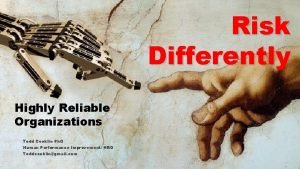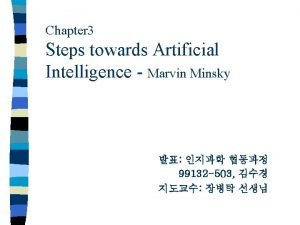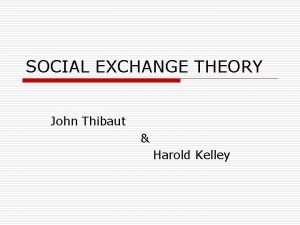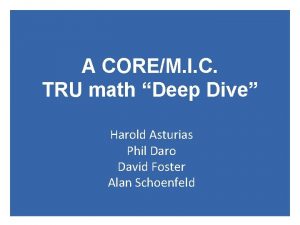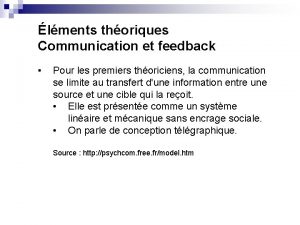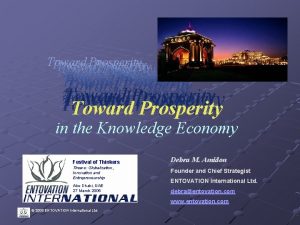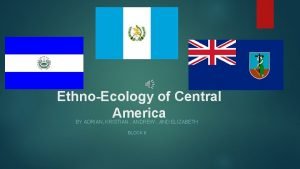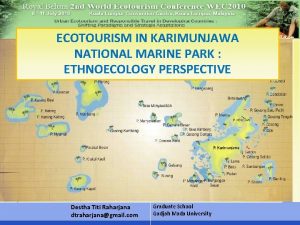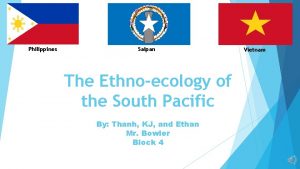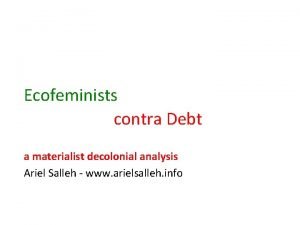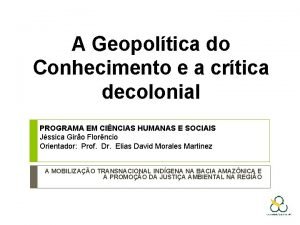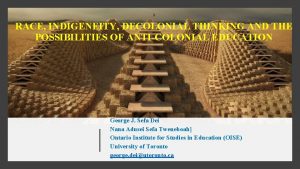Harold Conklin First steps toward a decolonial ethnoecology


























- Slides: 26

Harold Conklin: First steps toward a decolonial ethnoecology Satellite Image: Terraced landscape. Bannawol (Banaue), North Central Ifugao

Retired at Yale. Professor Emeritus of the Human Environment and Professor Emeritus of Anthropology. Considered one of the world’s leading authorities on ethnoscience, the manner in which inhabitants of a particular area perceive and treat the environment. Harold Conklin (1926 -2016)


Mindoro Island Hanunóo people and territory

• Conklin’s work focused on the indigenous knowledge of ethnoscience in ecological context, particularly in the Mindoro district, Philippines. Background • “An Ethnoecological Approach to Shifting Agriculture” published in 1954 in Transactions of the New York Academy of Sciences.

The shifting mosaic Goal is to present a better scientific understanding of socalled shifting agriculture. Argues against prevalent misconceptions of indigenous agroecological practices within the Western academy. Rejects the so-called ‘Green Revolution’ as a top-down corporate model.

Shifting Agriculture “For our purposes we may consider shifting cultivation, also known by such designations as fieldforest rotation …or slashand-burn agriculture, as always involving the impermanent agricultural use of plots produced by the cutting back and burning of vegetative cover. ” (241)

Culture-specific terms for rotation island agriculture • Philippines: kaingin (caiñgin) • Indonesia: ladang • Myanmar: taungya • India: djum • parts of Africa: chitemene • Central America: milpa

Popular (Mis)Conceptions of Shifting Agriculture • Haphazard; doesn't require labor input. • Swiddens usually cleared in areas of primary forest growth. • Fires escape plots and destroy nearby areas. • Swidden techniques are universally the same.

Popular Conceptions of Shifting Agriculture (cont. ) • Stoloniferous grasses are undesired in swiddens. • Swiddens are monocultures; thus their productivity can be measured in the yield of a single crop. • Efficiency can be measured by the ratio of single crop yield per unit of cultivated area. • Swiddens are abandoned following the harvest. • There's no crop rotation, only plot rotations. • "Native ignorance" leads to losses in fertility and permanent loss of forest cover when reclearing is more frequent than approx. 25 years.

Hanunóo TEK among the most extensive in world

Conklin does not mention this but the Hanunóo have 92 different names for rice including: shelled/unshelled, pounded/unpounded, dry, wet, fluffy, sticky, full colored, etc. Rice

Methods • Conklin lived with the Yagaw Hanunóo of Mindoro Island in the Philippines from November 1952 to January 1955. • He conducted participantobservation and (ostensibly) ethnographic interviewing.

Activities resulting in a slashed clearing, a gamasun. Activities resulting in a burned clearing, a tutud. Jan. –Feb. Mar. –May Activities resulting in a riceless field, a dayamihan. Oct. –Nov. First Year of a Cycle Feb. –Mar. May–Oct. Nov. –Dec. Activities resulting in a cut clearing, a buklid. Activities necessary for/resulting in the maintenance of a planted swidden (tanman). Activities resulting in a cleaned swidden, a lumun baguhan.

Hanunóo woman planting tubers

Sowing rice

Fencing around a cleared field ready for crops; note the intact canopy trees.

Weeding the forest garden Rice, maize, bananas, yams and sweet potatoes are the main staples grown, but a total of more than 80 other crops are interplanted in the forest clearings.

Activities resulting in a recleaned (used but still productive) swidden, a lumun da’an. After the First Year Perennial crops including fruit trees remain productive for an average of 2 to 5 years following the rice harvest.

Conclusions “Swidden farming follows a locally determined, well-defined pattern and requires constant attention throughout most of the year. ” (246) Second growth forests are preferred. They protect primary forest. Swiddens are contained by firebreaks. Techniques are specific to location and local conditions (i. e. topography, climate). Even the "weeds" are useful.

Conclusions 6. Swiddens are polycropped, polycropped meaning productivity can't be measured by the yield of a single crop. 7. Efficiency of swiddens should be measured by the ratio of total output (for all crops) to unit of labor (compare this to OFT of Hawkes et al. ). 8. Plantings and harvest overlap. 9. Hanunóo shifting cultivation involves crop rotations. Cycle lengths can't be assessed by measuring the time between clearances or rice harvests. 10. Because "many variables are at work, " it's difficult to prescribe an ideal minimum cycle length.

“A study of Hanunóo soil classification and associated ideas regarding suitability for various crops-other variables being equal--checked well with the results of a chemical analysis of soil samples. ” (246) Some final thoughts

Critique Hanunóo culture is not just about agroecological practices and ethnoecological knowledge: Music, dance, artisan crafts, and political organization are equally important. Some music is necessary before the “felling” of a secondary forest so music lays a role in these practices.

Critique Conklin’s focus on ethnoecological knowledge leads him to overlook the conflicts between the Hanunóo and religious missionaries seeking to Christianize the people.

Critique Poetry is important as a story-telling method for keeping track of historical events and values/worldviews important to the Hanunóo.

Some final thoughts “Biotic factors are most subject to control and experimentation by the Hanunóo, and are of the greatest concern to them. ” (246) Ethnobotany Plants teaching people how to live lightly with the land gently protecting and using them for food and medicine.
 Harold demsetz toward a theory of property rights
Harold demsetz toward a theory of property rights Todd conklin quotes
Todd conklin quotes John conklin uf
John conklin uf Whats a simile
Whats a simile Casting off with wind toward dock
Casting off with wind toward dock Steps toward artificial intelligence
Steps toward artificial intelligence Dotson
Dotson John thibaut dan harold kelley
John thibaut dan harold kelley Harold hütt herrera
Harold hütt herrera Harold cohen aaron
Harold cohen aaron Tindakan orang melayu menentang malayan union
Tindakan orang melayu menentang malayan union Klasifikasi negara menurut sinha
Klasifikasi negara menurut sinha Godfrey harold hardy
Godfrey harold hardy Harold brian minecraft
Harold brian minecraft Harold pincus
Harold pincus Why did harold macmillan resign
Why did harold macmillan resign Harold castilla cruz
Harold castilla cruz Harold hill nasa
Harold hill nasa Harold hill nasa
Harold hill nasa Edwin binney and harold smith
Edwin binney and harold smith Harold asturias
Harold asturias Hark the harold
Hark the harold Harold arlen somewhere over the rainbow
Harold arlen somewhere over the rainbow Feedback wiener
Feedback wiener Lasswells kommunikationsmodell
Lasswells kommunikationsmodell Manhattan project scientist harold
Manhattan project scientist harold Harold jacobs geometry
Harold jacobs geometry

